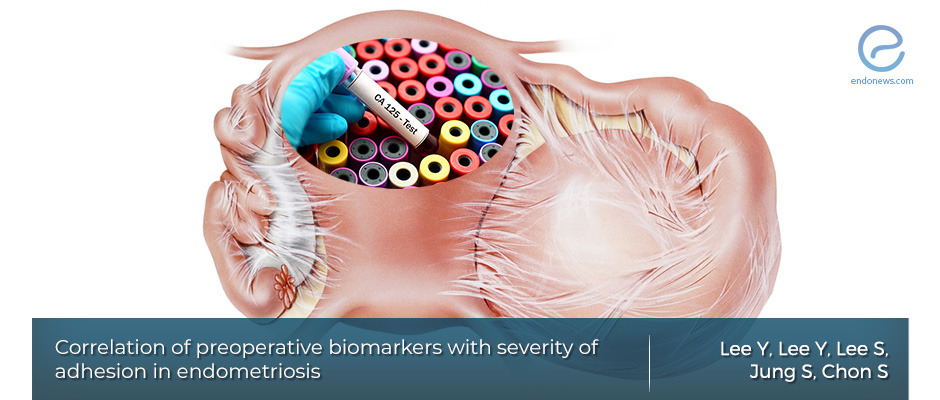Preoperative serum CA 125 levels predict the severity of adhesions in endometriosis
Feb 25, 2020
Preoperative serum CA 125 ≥ 35 U/mL have a higher risk for pelvic adhesion in endometriosis patients.
Key Points
Highlights:
- This is the first report to compare CA 125 level with revised American Fertility Society adhesion score in women with endometriosis.
Importance:
- Predicting the severity of adhesions before surgery may, therefore, assist clinically in several ways; cross-matching of blood units, performing bowel preparation and alerting the general surgeon and urologist for potential risk and related surgical complications can be done before the operation.
What’s done here?
- The preoperative correlation of pelvic adhesions with endometriosis was evaluated in patients by using serum markers their clinical value was explored for the prediction of adhesion.
- Preoperative blood Serum and CA 125 results were obtained and pelvic adhesion scores were calculated. The patient group with adhesion scores less than 28 points was defined as the mild adhesion group, and those with a score of 28 or more were members of the severe adhesion group.
Key Points:
- Patients in the severe adhesion group showed significantly higher CA 125 levels than in the mild adhesion group.
- The CA 125 level, size of the largest cyst, and WBC count were found to be associated with the level of pelvic adhesion.
- Adhesion scores were significantly higher in the CA 125 ≥ 35 U/mL group than in the CA 125 < 35 U/mL group.
- Patients with a preoperative CA 125 level higher than 35 U/mL are at high risk for pelvic adhesion.
Limitations:
- The study was retrospective and had a small sample size.
- Although each surgery was done in one center, the surgeon and the assistant were different.
- Since different gynecologists assigned individual revised American Fertility Society scores, there is a possibility that the differences in scoring may have produced erroneous classifications of patients into the two groups.
Lay Summary
Lee Y. et al., a group of researchers from Korea evaluated the correlation between preoperative serum markers and pelvic adhesions in endometriosis patients and explored the markers’ clinical value for outcome prediction. They have recently published their study in the Journal of Gynecology Obstetrics and Human Reproduction.
The researchers retrospectively reviewed the medical records of patients aged 19 to 52 years who underwent laparoscopy for histologic confirmation of endometriosis from January 2015 to December 2017. A total of 152 patients with endometriosis confirmed histologically were included in the study. The obstetric and gynecologic history, preoperative basic serum laboratory test and CA 125 results, type of surgery, and operation findings of the patients were assessed in detail. The revised American Fertility Society classification system, consisting of superficial or deep lesions of peritoneum and ovaries, filmy or dense adhesions of ovaries, tube adhesions, and degree of adhesion of PCDS, was used.
Of the 152 patients included in the study, 72 patients were placed in the mild adhesion group and 80 patients were placed in the severe adhesion group. Although no difference was found in parity or past operation history between the groups, the types of surgery, cyst location, the size of the largest cyst, mean WBC, neutrophil and platelet counts, and CA 125 level significantly differed. Laparoscopic unilateral ovarian cystectomy was the most common procedure in both groups (72.2% in the mild adhesion group and 46.3% in the severe adhesion group). In the mild adhesion group, left-sided cysts were most common (52.8%), whereas bilateral cysts were the most common in the severe adhesion group (36.3%). The mild adhesion group had 54.2% stage 3 adhesions, while stage 4 (96.3%) was predominant in the severe adhesion group. The size of the largest cysts was also significantly different between the mild adhesion and severe adhesion groups.
The cut-off values for the allocation of patients to the mild adhesion or severe adhesion groups were 35 U/ mL for CA 125, 5 cm for the size of the largest cyst, 5680 /mL for WBC count, 59.1% for neutrophil proportion, and 261,000 /mL for platelet count.
The statistically significant risk factors associated with adhesion were CA 125 ≥ 35 U/mL, size of largest cyst ≥ 5 cm, and WBC count ≥ 5,680 cells/mL.
All adhesion scores were found to be significantly higher in the CA 125 ≥ 35 U/mL group than in the CA 125 < 35 U/mL group. The size of largest cyst was also significantly different between the CA 125 ≥ 35 U/mL (5.5 ± 2.0 cm) and CA 125 < 35 U/mL (6.5 ± 2.9 cm) groups. Cyst location also differed significantly; left side cyst proportion was 52.1% in the CA 125 < 35 U/mL group and 37.0% in the CA 125 ≥ 35 U/mL group. For the laboratory tests, only WBC was significantly different between the two groups.
None of the patients had severe complications, including injuries of the bladder, ureter, bowel, or vessels nor were there any cases of laparotomic conversion.
In summary, CA 125 level, size of the largest cyst, and the WBC count are associated with the presence of pelvic adhesions. CA 125 ≥ 35 U/mL had a high risk for pelvic adhesions. Predicting the severity of adhesions before surgery may assist clinically in several ways; cross-matching of blood units, performing bowel preparation and alerting the general surgeon and urologist for potential risk and related surgical complications can be done before the operation. To support clinical decisions on the required approach to surgery in endometriosis patients, the results of the current study may be used.
Research Source: https://www.ncbi.nlm.nih.gov/pubmed/31520750
endometriosis tissue adhesions CA 125 laparoscopy surgery revised American Fertility Society classification

